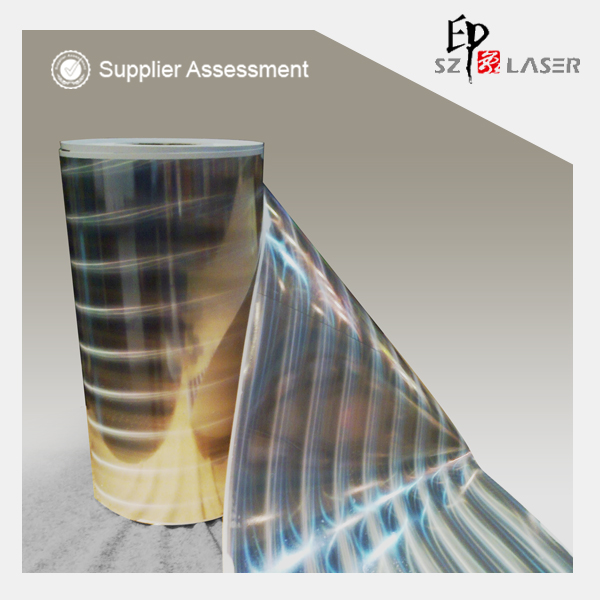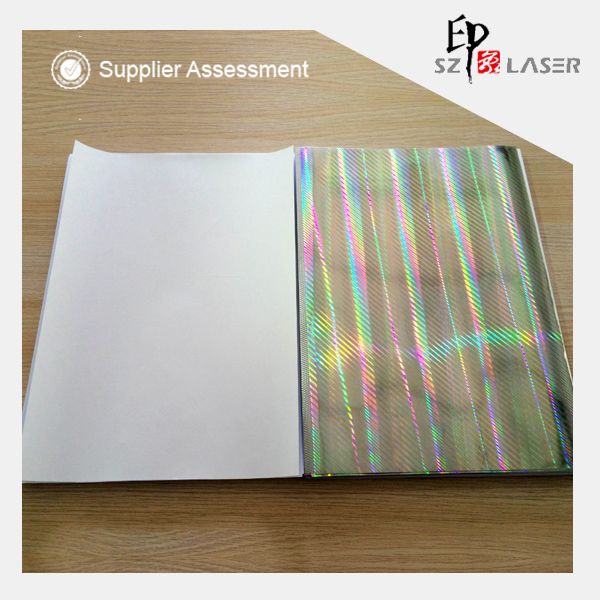Printable Silver Metallized Laser Holographic Transfer Paper
Our company produce all sorts of Metallized Holographic Paper, Silver Hologram Paper, Silver Hologram Paper , Laser Hologram Paper, Holographic Transfer Paper. Please see the specificaton below.
Material
Laser transfer package paper/ thin paper/ leather
Weight
14-157grams
Color
Silver/ Gold/ Red- with hologram LOGO
Effect
Brightness Hologram security features, colorful printing
Design
Customized
Size
According to the book size/ customized acceptable
MOQ
10,000 pieces
Freight
By express(DHL/FEDEX/UPS/ARMARX), By air, By sea
Rainbow pillar pattern Silver Hologram Paper
Hologram Paper can be used for gift, food, medicine, cosmetic, personal care, etc Packaging. Except this, it also can be applied to booknote cover.
If you need these hologram papers, please contact us.
First, electronic paper and its characteristics
Electronic Paper, also known as Digital Paper, is an ultra-thin, ultra-light display that looks very similar to plain paper and folds like a newspaper, but its essence is similar to plain paper. The difference between heaven and earth.
1. Electronic Paper Control Drive Element - Plastic Transistor
One of the key technologies of electronic paper is the plastic transistor (or organic transistor) technology. The plastic transistor is a transistor formed based on a carbon base compound and does not require a complicated production process like amorphous silicon resin.
Another key technology of electronic paper is the electronic ink technology. The electronic ink is composed of millions of tiny ball sealing units. The electric field is changed by the plastic transistor to display the image.
Ordinary silicon-based semiconductor transistors are non-collapsible, and a few years ago, the advent of plastic transistors made folding electronic paper a reality.
The emergence of plastic transistors depends on the invention of conductive plastics. People generally think that plastics cannot conduct electricity, but physicists have discovered that some plastics can conduct electricity, and they began to study the electrical properties of organic materials. In 1995, Bell Labs made P-type semiconductors from plastic; in 1998, researchers at Bell Labs made P-type plastic semiconductor materials with high field-effect mobility and developed practical plastic transistors. It is the most ideal control element for electronic paper.
The first step in the manufacture of thin-film transistor integrated circuits (plastic chips) is to prepare the substrate. The choice of substrate is relatively simple and inexpensive. Insulating plastics are usually used. The solution containing the conductive polymer is then applied to the substrate using a spin coating or immersion coating. In principle, plastic solutions can even be printed directly on the substrate like printing inks.
Rotary film is an advanced technology, it can provide plastic film thickness of only 100 ~ 200nm. During production, the solution is poured onto a substrate that is rotating at a high speed, and a film can be formed immediately. When the solvent evaporates, the plastic film adheres to the substrate and becomes a conductive or semiconductive material.
Foldability is the first advantage of plastic chips, because it is made of organic materials such as polymers, can be made very thin, the thickness is calculated in nanometers, and second, the price is low because the production process of polymers is higher than that of silicon. Product requirements are low, and the requirements for production conditions are not high, so the cost is naturally low; in addition, the chip can also be made very large, so that the electronic paper has a large-size display area.
2. Electronic Paper Display Elements - Electronic Ink
On the plastic film substrate, composed of upper and lower transparent electrode sheets, the flexible electronic transistor can bend the early electronic ink between the electrode plates is based on the principle of electrophoresis, driven by the electric field charged pigment particles, resulting in color contrast to display information, as shown in picture 2. The charged white particles are dispersed in the blue electrophoresis solution and the white particles are electrophoresed with a voltage to show white or blue. When the white particles are attracted to the top, the surface becomes white, and if the white particles are moved to the lower part, the surface will show blue of the electrophoretic fluid. However, the electronic ink manufacturing process is complicated, the cost is high, and the service life is short.
Electron inks, which are now widely concerned, are composed of a myriad of tiny transparent microcapsules with a diameter of about 100 μm. This tiny particle has a transparent shell with a black dye and some tiny white particles inside it. The white particles are not blackened by the dye, and they can induce electric field charges and move in different directions. When an electric field is applied to the electrodes on either side of each microcapsule, the white particles move in one direction, so that through the transparent housing and the electrode sheet, the material surface is white; when the opposite electric field is applied, the white particles are Move to the other side of the microcapsule and the surface of the material is black.
The electronic ink particles are small, to a certain extent overcome the shortcomings of early electronic ink particles are too large, easy to deposit and cause image non-uniformity and short life. However, due to the disorderly arrangement of the microcapsules and the like, it is also unable to achieve a good color display, so the current electronic ink can only achieve two-color display characteristics.
3. The characteristics and development of electronic paper
(1) Characteristics of electronic paper
1 similar to the reading effect of paper. Electronic paper is displayed on the basis of Lambertian reflection principle. Without radiation like an electronic display, it will not harm human eyes; it has the same high contrast, wide viewing angle and high definition as paper prints, and is suitable for human eyes.
2 easy to carry. E-paper is ultra-lightweight and ultra-thin and can be folded or rolled up and can be made into a surface of almost any shape.
3 free reading methods. Since e-paper has the same readability as traditional paper, people can read e-paper information as easily as they can see the print media.
4 The power consumption is extremely low. Since the electronic paper is completely reflective, it does not require a high-powered backlight, and it is bistable (the performance of the electronic paper can be displayed for a long time in an unpowered state and is called bistable), so its power consumption Lower than any current display device.
(2) Development Trend of Electronic Paper
As electronic paper has just been born, there are many technical obstacles that cannot be produced on a large scale. First of all, its raw materials are some high-tech materials, and the production technology is not mature, so the production cost is high. Second, the flip display speed is slow, so its development goal is to be able to quickly process full-screen video information; Third, can not be color display, the current electronic paper can only support black and white, and the resolution is also low, so the display is not yet complete As expected.
However, with the improvement of processing technology and microcapsule structure, these problems will be gradually solved, and electronic paper will have all the advantages of traditional paper and electronic display. For example, the Microcup electronic ink developed by SiPix in the US can inject the red (R), green (G), and blue (B) color electrophoresis liquids into the microcups and encapsulate them in a special way. The circuit design and driving method make efficient full-color electronic paper. Xerox is discussing the use of color filters to reduce the size of the microcapsules to 30μm, making it possible to display electronic paper in color.
(to be continued)
Pillar of light Hologram Paper


Hologram Paper
Metallized Holographic Paper, Silver Hologram Paper, Silver Hologram Paper, Laser Hologram Paper, Holographic Transfer Paper
Suzhou Image Laser Technology Co., Ltd , http://www.nip-optics.com